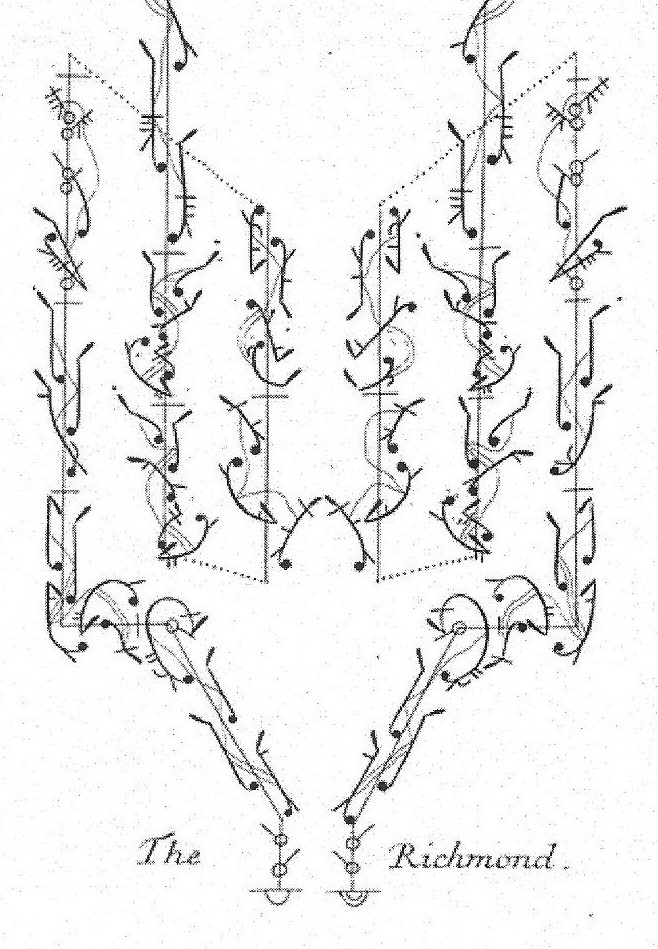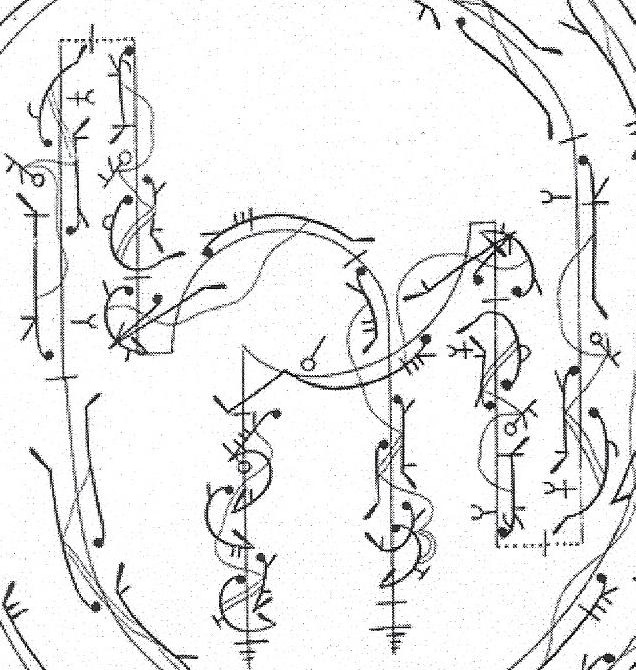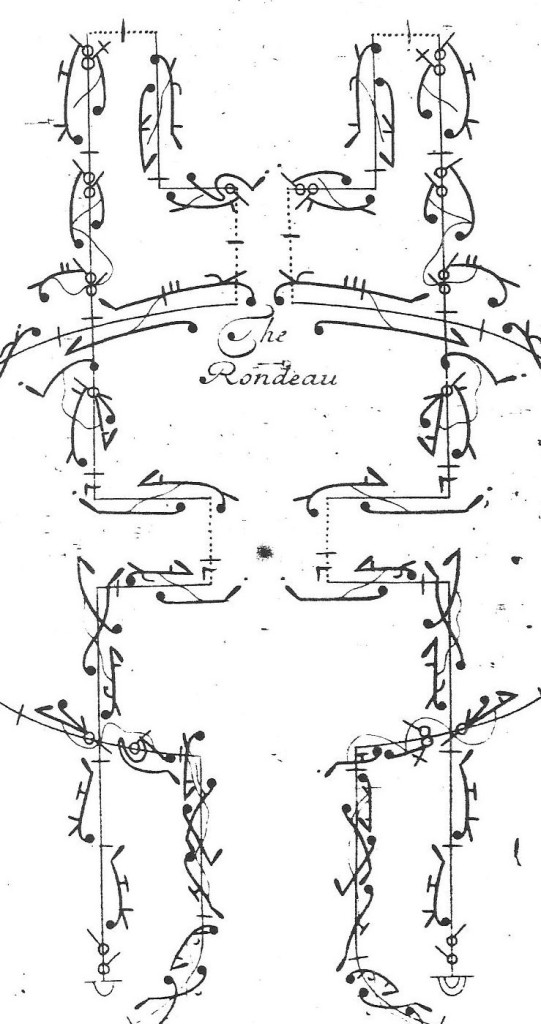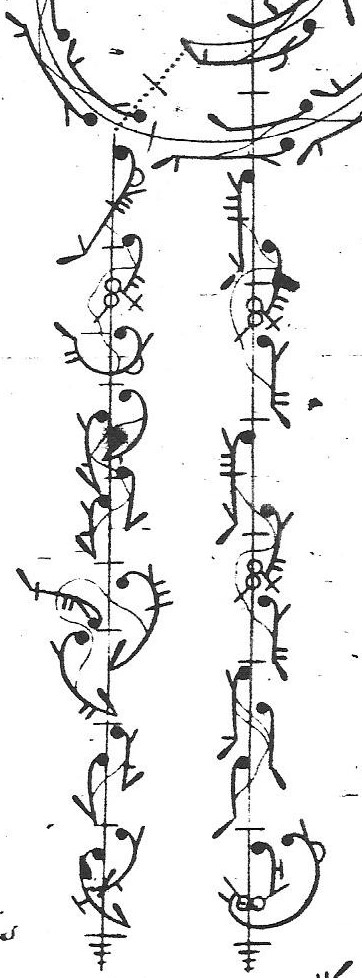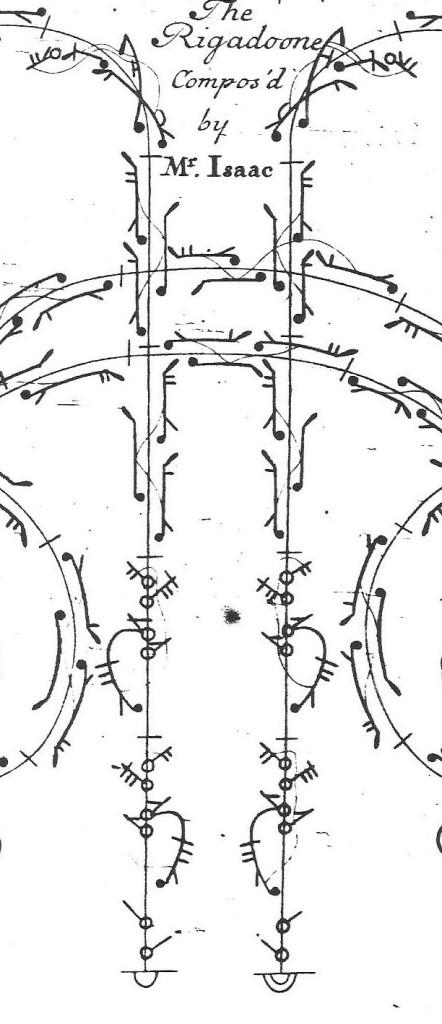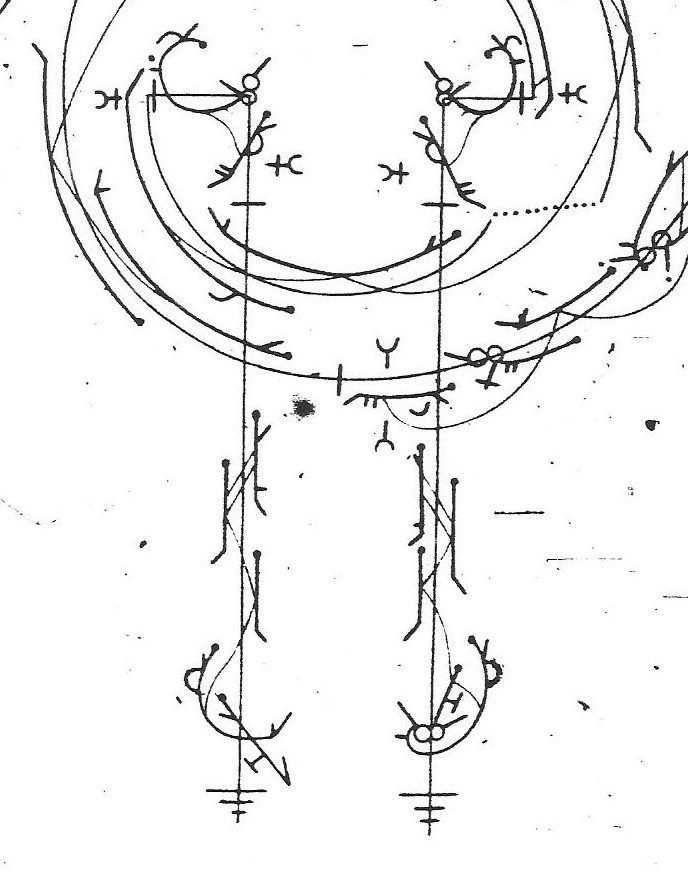Apart from a solo Chacone and Minuet for a girl (perhaps two separate solos), Mr Isaac’s choreography survives in twenty-one ballroom duets published between 1706 and 1716. Of these, eleven were said to have been ‘Perform’d at Court’ (another, The Northumberland, may also have been danced at court), while another seven were advertised as ‘Made for Her Majesty’s Birth Day’. Two were called a ‘new Dance for the Year’ – they were danced on stage and may have been originally intended for that purpose.
In her 1985 thesis (p. 229), French Court Dance in England: A Study of the Sources, Carol Marsh identified nine country dances that used music from Isaac’s ballroom dances (some used only one section from the music for a multi-partite dance). There appears to be no suggestion that these were created by Mr Isaac himself, although most were published close in date to his ballroom duets. There is also Isaac’s Maggot, in the ninth edition of The Dancing-Master published in 1695, which might be by him. I don’t intend to pursue any of these here or in future posts, although they may well be worth further research by those well-versed in country dances and their history.
In this post, I will look at two of the choreographic conventions demonstrated, or disregarded, in the six of Isaac’s dances published together in 1706. I will investigate some of his more idiosyncratic figures and steps in my next post. Behind this line of enquiry lies the issue of the notation, what it can (and can’t) notate, notational errors and (with Isaac’s other dances) the different approaches of individual notators and engravers. John Weaver was the notator of the six Isaac dances (which were published the same year as Orchesography, Weaver’s translation of Feuillet’s Choregraphie), but at least two engravers prepared the plates from which they were printed. I will touch on these issues in my analyses, although work on the styles and practices of engravers, and notators, really needs to be done through close examination of the originals.
Early in my involvement in baroque dance, I encountered what were identified as choreographic conventions within the genre. There were two in particular: dances opened with a passage travelling downstage towards the audience, or for ballroom dances – the presence; they ended with another passage travelling upstage so that the dancers returned to their starting point. These conventions provide a useful starting point for a brief analysis of Isaac’s six dances.
Here are the opening and closing figures for each of the six dances.
The Richmond:
In the opening A section of the music for The Richmond (4 bars), the two dancers move downstage on a diagonal but quickly turn to face each other. They move sideways for one step, then turn to face the presence for two steps. Isaac divides the focus of the dancers between each other and the presence. They are closer together than appears on the notation.
The closing sequence (the final 4 bars, a petite reprise to the last section of the music) has the couple (who are improper) take inside hands as the man moves upstage and lady downstage. They then turn and repeat their pas composé taking other hands. On the next, penultimate, step they let go hands and change sides for their final step in which the man dances backwards and the lady dances forwards. She makes a half turn on the coupé soutenu into fourth position, with which they both finish.
The Rondeau:
Apart from one step, in bar 3, in which the couple face each other for a brief acknowledgement, the convention of facing and travelling downstage towards the presence is observed throughout the first 8-bar musical section. The two coupés sans poser sideways (in bars 4 and 5) would have travelled less than the notation suggests.
The Rondeau ends with a minuet and the closing figure uses the convention of the man travelling backwards, while his lady travels forwards – as if they had taken both hands, although no hand holds are shown on the notation. His final coupé soutenu ends in fourth position, while hers ends in first position implying that they immediately perform an honour.
The Rigadoon:
Isaac gives The Rigadoon, his most famous dance, an entirely conventional opening sequence, with the two dancers travelling downstage side-by-side towards the presence throughout the first A section (before turning their backs as they begin the second A).
The closing sequence is actually a repeat, with variations, of the steps from the opening of The Rigadoon. The man moves backwards as the woman dances forwards and she turns to face the presence only on her final step – both ending with a coupé soutenu into fourth position.
The Favorite:
Apart from their initial steps in The Favorite, which include coupés sideways towards and away from each other, the couple travel directly downstage side-by-side towards the presence, making this a conventional opening.
The Favorite is another dance for which the music ends with a petite reprise. In these final four bars, the two dancers face each other or upstage, travelling upstage on a diagonal before ending with a quarter-turn (not indicated on the notation) into a coupé soutenu into fourth position.
The Spanheim:
In The Spanheim the dancers face one another on their first step and travel sideways downstage on the next, before turning to face the presence to continue travelling downstage with their next two steps to complete the first A section of the music.
The final musical section of The Spanheim has six bars. For the first three the couple travel upstage together, turning to face the presence at the end of their second step. The floor pattern for the last three bars is more complex, using diagonals and a curving track before they make a quarter turn to face the presence at the very end. The man does a coupé soutenu into fourth position and the woman into first, so this dance also seems to end with an immediate honour.
The Britannia:
The A section in The Britannia is longer than usual, with 10 bars, and begins unconventionally with the dancers facing one another for the first 5 bars, before turning to face the presence for a sequence which travels sideways moving away, towards and away from each other.
The Britannia ends with a minuet, like The Rondeau, and Isaac also uses a variation on the taking of both hands (in this dance the notation indicates that the couple do take hands). Their final retreat is shorter (three bars of music – equivalent to one and a half minuet steps) and ends with coupés soutenus into fourth and first respectively, so presumably straight into an honour.
Although each of these dances keep to the general conventions in their opening and closing passages, Isaac is inventive in his variations of these. In all but The Rigadoon, his dancers acknowledge each other in some way. In The Richmond, The Spanheim and The Britannia their opening steps and figures are directed to each other and they only turn to the presence some way into the opening section. I am wondering whether these differences, subtle as they may seem, point to different contexts for their performance or perhaps to Isaac interpretating a theme within his music or the dance’s title. As I work on these choreographies, I question how formal were the balls at which they were performed. Were some of them danced at private or semi-private events before a small royal and aristocratic group, rather than at royal balls given before a wider audience?
The variations in the closing steps are interesting. In Le Maître à danser, published some twenty and more years later than the creation of Isaac’s six dances, Rameau specifies that at the ‘grand Bal du Roy’ and ‘Bals reglez’ honours must be made at both the beginning and end of each couple dance (pages 54, 56-57). These honours are rarely notated in the surviving dances and Weaver’s notations for Isaac seem to hint at differences in practice, signalled by the finishing position of the woman. Do these, too, point to a less formal context for the performance of some of the dances?

